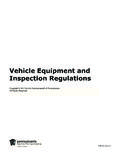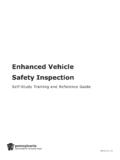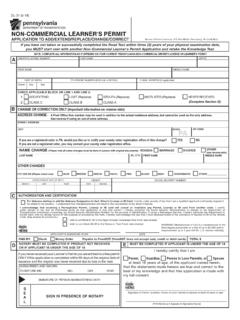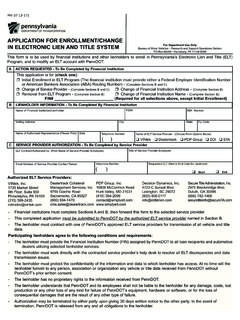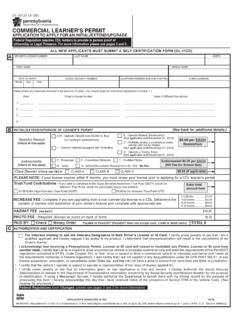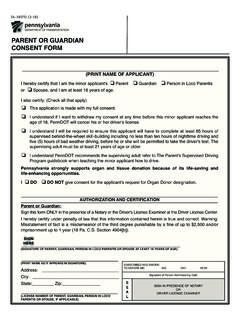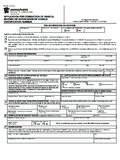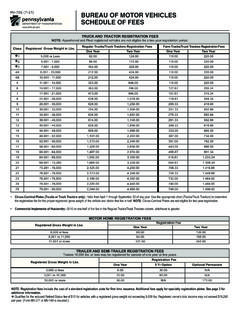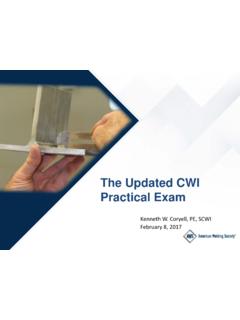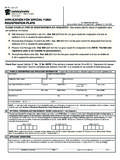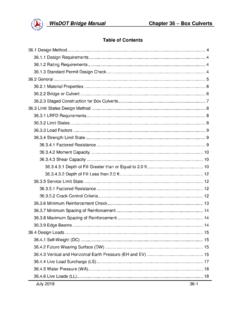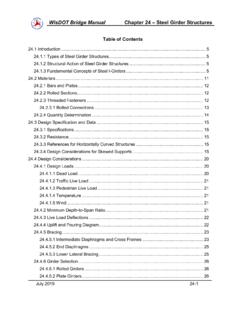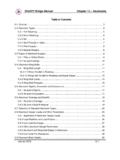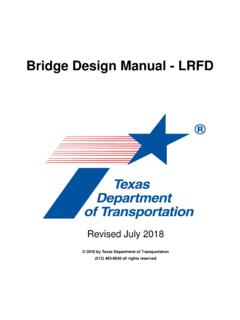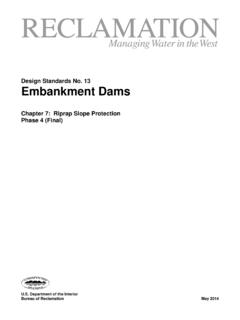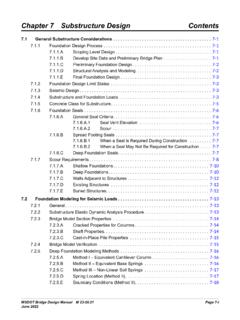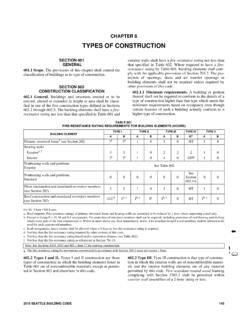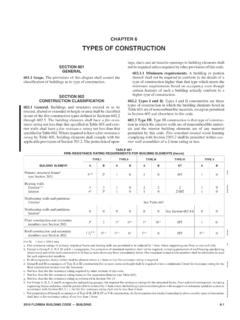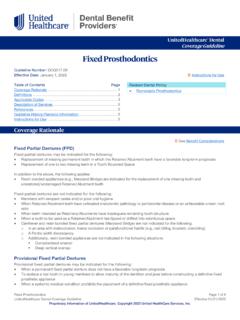Transcription of CHAPTER 8 DRAINAGE AND DRAINAGE SYSTEMS
1 CHAPTER 8: DRAINAGE and DRAINAGE SystemsPUB 23 - MAINTENANCE MANUAL8-iUpdate #1Ch. Updated 10-12 CHAPTER 8 DRAINAGE AND DRAINAGE SYSTEMSTABLE OF General Considerations .. Surface Water DRAINAGE .. Authorization to Enter Private Property for DRAINAGE Activities.. Driveways and DRAINAGE Problems .. DRAINAGE Maintenance Responsibilities ConcerningMunicipalities.. Pipes, Culverts, Inlets, Endwalls.. Subsurface Water DRAINAGE .. Erosion and Sedimentation Control .. 8-13kw PROOF 9 10/4/12 @ 12:15 pmChapter 8: DRAINAGE and DRAINAGE SystemsPUB 23 - MAINTENANCE MANUAL8-iiUpdate #1Ch. Updated 10-12kw PROOF 9 10/4/12 @ 12:15 GENERAL CONSIDERATIONS DRAINAGE is an essential element to beconsidered in the maintenance of a highwaysystem. The purpose of a highway drainagesystem is to convey water away from the road asquickly as possible to prevent erosion of theroadway and saturation of the subgrade, and toprevent standing water or ice on the roadwaysurface.
2 An efficient highway DRAINAGE systemprovides for the disposal of surface water from theroadway section and the elimination or control ofsubsurface water. Included in a surface DRAINAGE system are theroadway crown, shoulder, curbs, gutters, dropinlets, storm drains, ditches/swales andpipes/culverts. A surface DRAINAGE system isprovided to permit water to flow from theroadway surface as rapidly as possible and awayfrom the highway. Subsurface DRAINAGE SYSTEMS include pipeunderdrains, pavement base drains andcombination storm sewer and of these are shown on Publication 72M,Standard Drawing objective of asubsurface DRAINAGE system is to convey away anywater that gets into base material. Subsurfacedrainage is a practical and economical way ofmaintaining firm, stable subgrades and structurefoundations, eliminating saturated ground andpreventing or reducing frost heave.
3 All DRAINAGE facilities should be maintained inoperating condition to work as designed, withspecial attention given to fall cleaning so thatstructures will be ready to handle spring andsummer rains. This requires year-roundmaintenance with emphasis on side ditch cleaningin the fall and early cleanup in the spring. Properly cut shoulders allow water to drainaway from the road surface and to flow to thenearest inlet or swale. Side dozing operations(removal of accumulated material from beneathguiderail) on unpaved shoulders and sideapproaches provides efficient DRAINAGE . Pub. 23, CHAPTER 5contains additional informationconcerning shoulders. Routine maintenance of DRAINAGE systemsshould consist of periodic inspections, to includepre and post storm inspections, and drainagecleaning activities. Regular inspections should beconducted to confirm that satisfactory conditionsexist and to evaluate needs for cleanup and settling of an area or part of a roadway(usually with pavement breakups or cracks)during or following the wet season is generally anindication that a DRAINAGE problem may exist.
4 In summary, proper DRAINAGE can keep waterfrom collecting on and under a pavement. Keepingthe subsurface properly drained will insurestability and minimize maintenance costs. Exhibits1 and 2, Background for DRAINAGE FacilitiesPolicy and Sources of Curb-to-CurbMaintenance Policy , respectively, will be helpfulas handouts and reference documents wheninterfacing with the SURFACE WATER DRAINAGE Two types of water courses that handle surfacedrainage are natural water courses and manmadewater courses. Natural water courses consistmainly of rivers and streams but may be a valleyor swale that directs water into a river or important part of DRAINAGE maintenance is thecleaning of obstructions such as trees, branches,boulders and sandbars from around bridgestructures to ensure that stream flow is notdirected toward bridge abutments.
5 All surface water should eventually lead to thegroundwater and/or a natural watercourse. Inorder to accomplish this, manmade watercoursesare constructed which include open drainagesystems such as ditches, detention basins, swalesand gutters, or enclosed DRAINAGE structures suchas pipes/culverts, which cross under or runparallel to a roadway and outlet to a natural watercourse. Ditches/swales are generally classified asparallel ditches, diversion ditches and inlet oroutlet ditches. Parallel ditches are channels that areconstructed parallel to the roadway for thepurpose of carrying runoff coming from thepavement, shoulders and adjacent areas. They areusually open unless crossing under side roads,driveway or walkways. A parallel ditch may belined with paving material in mountainous terrainto limit erosion or they may be sodded or in anatural state provided it is adequate toaccommodate the design capacity.
6 Diversion ditches are constructed parallel to thetop of a cut and are intended to intercept surfacedrainage from flowing over the face of the slope,thus preventing erosion and slides due toexcessive moisture. They may be paved orunpaved, depending again on design capacity. CHAPTER 8: DRAINAGE and DRAINAGE SystemsPUB 23 - MAINTENANCE MANUAL8-1 Update #1Ch. Updated 10-12kw PROOF 9 10/4/12 @ 12:15 pm8-2 Update #1Ch. Updated 10-12 CHAPTER 8: DRAINAGE and DRAINAGE SystemsPUB 23 - MAINTENANCE MANUALI nlet and outlet ditches serve primarily to carrywater to and from cross pipes, are generallyperpendicular or slightly skewed to the centerlineof the road, and often extend from or onto privateproperty. PennDOT's responsibility to maintainthese ditches extends only as far as necessary toachieve free flow of DRAINAGE to and from the crosspipe, while avoiding excessive volume or velocityof water discharged onto private property.
7 Typical sections for parallel ditches anddiversion ditches are shown on Publication 72M,Standard Drawing RC-10M. Periodic inspections should be made, especiallyafter heavy rains and in the spring after snow andice melt. The inspection should include but notnecessarily be limited to: 1. Checking ditch line for uniformity andobstructions. 2. Checking side slopes for erosion and possibleneed for protection of erosion. 3. Checking condition of ditch paving materials. 4. Checking sediment deposits and weeds andbrush growth in ditch line. Ditches, swales and DRAINAGE channels shouldbe maintained to the line, grade, depth and crosssection to which they were constructed orsubsequently improved. They should be keptreasonably clear of weeds and obstructingmaterials which may restrict the normal flow ofwater. Presently approved herbicides (discussed inPublication 23, CHAPTER 13) are effective and maybe used for this purpose.
8 Paved ditches should bemaintained in a condition to ensure a smooth andimpervious surface to prevent underflow of and joints in asphalt or concrete pavedditches and paved gutters should be repaired asnecessary and the joints sealed. Gutters are channels or curbs used along theside of a roadway surface to collect and control theflow of water and direct it to an inlet or outletditch, a catch basin or shoulder drain leading thewater into a nearby stream or other naturalwatercourse. All ditches, swales and DRAINAGE channelsshould be kept clean of debris and trash. Anysettlement should be corrected and repairs ofbroken or eroded surfaces should be made withappropriate materials. Refer to Publication 113, Highway MaintenanceForeman Manual, Activity Numbers 711-7311 and711-7312-01 for additional information concerningactivity requirements and production andplanning units.
9 AUTHORIZATION TO ENTERPRIVATE PROPERTY FORDRAINAGE ACTIVITIES The purpose of this section is to clarifyprocedures for the Department or its authorizedrepresentatives to enter upon any property if entryis necessary to correct, maintain or restore existingdrainage facilities. Section 417, State Highway Act of 1945, the Commonwealth's position and thefollowing policies and procedures discussed inthis CHAPTER concerning this subject. This policy applies in all cases where work is tobe done by PennDOT Maintenance Forces or bycontractors which have been engaged byPennDOT. DRAINAGE problems usually result from either anatural impairment ( , growth of weeds orsiltation) or a physical blockage, intentional by theproperty owner. In the case of a naturalimpairment of DRAINAGE facilities requiring entryonto private property, the first step should bepersonal contact with the property owner toexplain the problem and our plan to correct s' representative should request theproperty owner to sign an RW-397 "Authorizationto Enter (Non-Waiver of Claim)" or an RW-397A"Authorization to Enter (Waiver of Claim)" forPennDOT's protection.
10 However, refusal of theproperty owner to sign the form does not preventPennDOT from taking necessary corrective the property owner refused to allow PennDOTto enter the property to correct the problem, heshould be sent a certified letter informing him ofthe problem, our plan to correct the problem andthe date we intend to enter. The corrective workshould then be performed on the date RW-397 or RW-397A Forms may be obtainedfrom the District Right-of-Way : If a dangerous condition exists on thehighway because of blocked DRAINAGE , theMaintenance Manager should act as soon aspossible to correct the problem. Although thepreceding steps are not required, personal contactshould be made when and where possible. kw PROOF 9 10/4/12 @ 12:15 pmIn the case of a physical blockage caused by theproperty owner, the first step is also personalcontact with the property owner.
